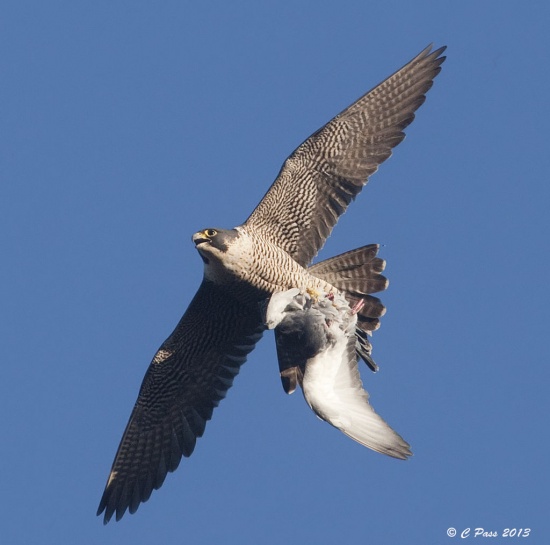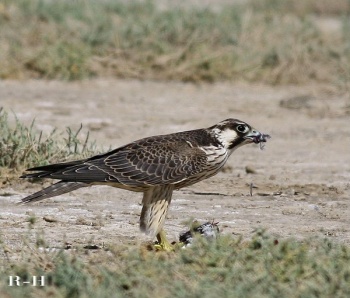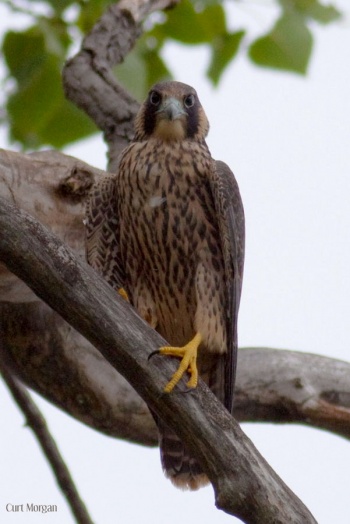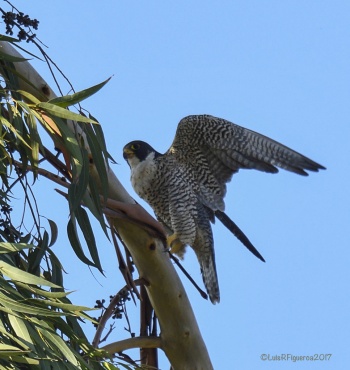Nutcracker (talk | contribs) (more details) |
Nutcracker (talk | contribs) (more details) |
||
| Line 1: | Line 1: | ||
[[Image:Peregrine with prey.jpg|thumb|550px|right|''F. p. peregrinus'' with prey<br />Photo by {{user|acorn|Colin Pass}}<br/ >[[UK]], April 2013]] | [[Image:Peregrine with prey.jpg|thumb|550px|right|''F. p. peregrinus'' with prey<br />Photo by {{user|acorn|Colin Pass}}<br/ >[[UK]], April 2013]] | ||
;[[:Category:Falco|Falco]] peregrinus | ;[[:Category:Falco|Falco]] peregrinus | ||
| − | '''Includes Cape Verde Peregrine Falcon and | + | '''Includes Barbary Falcon, Cape Verde Peregrine Falcon, and Shaheen Falcon''' |
==Identification== | ==Identification== | ||
[[Image:Peregrine_Falcon.jpg|thumb|350px|right|''F. p. macropus''<br/>Photo by {{user|RMD|RMD}}<br/>Nhulunbuy [[Northern Territory]], [[Australia]]]] | [[Image:Peregrine_Falcon.jpg|thumb|350px|right|''F. p. macropus''<br/>Photo by {{user|RMD|RMD}}<br/>Nhulunbuy [[Northern Territory]], [[Australia]]]] | ||
| Line 13: | Line 13: | ||
'''Juvenile''': dark brown above, streaked below; cere, eye ring and feet greyish | '''Juvenile''': dark brown above, streaked below; cere, eye ring and feet greyish | ||
====Variations==== | ====Variations==== | ||
| − | + | Marked, in size, mantle shade (mid-grey to nearly black), and head pattern, particularly the width of the moustachial stripe; in general, high latitude subspecies are larger and paler overall, and low latitude birds small (following [[Dictionary_A-C#B|Bergmann's rule]]), while dry climate subspecies are pale, and humid climate subspecies darker, to nearly black above (following [[Dictionary_G-L#G|Gloger's rule]]). See '''Subspecies''' below for more details. | |
==Distribution== | ==Distribution== | ||
Almost worldwide - the most widely distributed bird of any, absent only from New Zealand and polar regions. See taxonomy, below, for more detail by subspecies. | Almost worldwide - the most widely distributed bird of any, absent only from New Zealand and polar regions. See taxonomy, below, for more detail by subspecies. | ||
| Line 19: | Line 19: | ||
Large areas of [[Europe]] and [[North America]] lost all or almost all of their Peregrine Falcons for a period in the late 20th century due to combinations of poisoning by persistent toxic pesticides like DDT and illegal persecution; following restrictions on persistent pesticides, reintroduction and natural recovery has allowed populations to recover in most areas, but illegal persecution remains a serious limiting factor in some areas, notably in upland [[Britain]]. Capture of birds for falconry use has also caused losses in some areas. Conversely, the adoption of tall buildings for nest sites has allowed Peregrine Falcons to expand into urban habitats, often in areas which lacked any natural nest sites. | Large areas of [[Europe]] and [[North America]] lost all or almost all of their Peregrine Falcons for a period in the late 20th century due to combinations of poisoning by persistent toxic pesticides like DDT and illegal persecution; following restrictions on persistent pesticides, reintroduction and natural recovery has allowed populations to recover in most areas, but illegal persecution remains a serious limiting factor in some areas, notably in upland [[Britain]]. Capture of birds for falconry use has also caused losses in some areas. Conversely, the adoption of tall buildings for nest sites has allowed Peregrine Falcons to expand into urban habitats, often in areas which lacked any natural nest sites. | ||
==Taxonomy== | ==Taxonomy== | ||
| − | [[Image:BARBARYFALCON.jpg|thumb|350px|right|Barbary Falcon (''F. p. pelegrinoides'')<br />Photo by {{user|RASHED|rashed}}<br />[[Kuwait]]]] | + | [[Image:BARBARYFALCON.jpg|thumb|350px|right|Barbary Falcon (''F. p. pelegrinoides''), immature<br />Photo by {{user|RASHED|rashed}}<br />[[Kuwait]]]] |
| − | ''F. p. pelegrinoides'' (sometimes together with ''F. p. babylonicus'') has been separated as '''Barbary Falcon'''. However, at the moment only IOC accept this split<sup>[[#References|[1]]]</sup> | + | ''F. p. pelegrinoides'' (sometimes together with ''F. p. babylonicus'') has been separated as '''Barbary Falcon'''. However, at the moment only IOC accept this split<sup>[[#References|[1]]]</sup>. |
====Subspecies==== | ====Subspecies==== | ||
| − | [[Image:Peregrine juv.jpg|thumb| | + | [[Image:Peregrine juv.jpg|thumb|350px|right|Juvenile ''F. p. anatum''<br/>Photo by {{user|CurtMorgan|CurtMorgan}}<br/ >Upstate [[New York]], [[USA]], June 2009]] |
19 subspecies are currently recognised<sup>[[#References|[2]]]</sup>: | 19 subspecies are currently recognised<sup>[[#References|[2]]]</sup>: | ||
*''F. p. anatum'' | *''F. p. anatum'' | ||
| − | :*[[North America]] (south of tundra) to northern [[Mexico]] | + | :*[[North America]] (south of tundra) to northern [[Mexico]]. Similar to nominate. |
*''F. p. tundrius'' | *''F. p. tundrius'' | ||
| − | :*Arctic tundra of [[North America]] ([[Alaska]] to [[Greenland]]) | + | :*Arctic tundra of [[North America]] ([[Alaska]] to [[Greenland]]) Very large, pale. |
*''F. p. calidus'' | *''F. p. calidus'' | ||
| − | :*Tundra of [[Eurasia]] (Lapland to northeast Siberia) | + | :*Tundra of [[Eurasia]] (Lapland to northeast Siberia). Very large, pale. |
*''F. p. pealei'' | *''F. p. pealei'' | ||
| − | :*Coastal western [[North America]] (Aleutian Islands to Washington) | + | :*Coastal western [[North America]] (Aleutian Islands to Washington). Large, dark. |
*''F. p. cassini'' | *''F. p. cassini'' | ||
| − | :*Western [[South America]] (Ecuador to Tierra del Fuego and Falkland | + | :*Western [[South America]] ([[Ecuador]] to Tierra del Fuego and [[Falkland Islands]]). Variable, some dark, others (formerly sometimes split as subspecies ''kreyenborgi'') much paler. |
*''F. p. japonensis'' | *''F. p. japonensis'' | ||
| − | :*Northeast [[Siberia]] to Kamchatka Peninsula and [[Japan]] | + | :*Northeast [[Siberia]] to Kamchatka Peninsula and [[Japan]]. |
*''F. p. furuitii'' | *''F. p. furuitii'' | ||
| − | :*On the Volcano Islands and Bonin Islands east of [[Japan]] | + | :*On the Volcano Islands and Bonin Islands east of [[Japan]]. |
*''F. p. peregrinus'' | *''F. p. peregrinus'' | ||
| − | :*Northern [[Eurasia]] (south of the tundra) | + | :*Northern [[Eurasia]] (south of the tundra). Fairly large (male 580-750 g, female 920-1300 g); slate grey above, grey barred below with variable buff wash on breast. |
*''F. p. brookei'' | *''F. p. brookei'' | ||
| − | :*Mediterranean basin east to the Caucasus Mountains | + | :*Mediterranean basin east to the Caucasus Mountains. Smaller than nominate (male 445 g, female 800-920 g); plumage similar but with slightly darker breast. |
| − | *''F. p. pelegrinoides'' | + | *''F. p. pelegrinoides'' - '''Barbary Falcon''' |
| − | :*[[Canary Islands]] and north [[Africa]] ([[Morocco]]) to west [[Iran]] | + | :*[[Canary Islands]] and north [[Africa]] ([[Morocco]]) to west [[Iran]]. Small (male 330-400 g, female 500-850 g, only about half the weight of ''F. p. calidus''); pale, with narrower moustachial stripe, forecrown black, rear crown rusty red-brown, whitish breast weakly barred with brown bars, mantle mid to pale grey. |
| + | *''F. p. babylonicus'' - '''Barbary Falcon''' | ||
| + | :*Eastern [[Iran]] to [[Mongolia]]. Small; very pale, with weak moustachial stripe, forecrown grey, rear crown orangey-brown, whitish breast, and pale grey mantle. | ||
*''F. p. madens'' | *''F. p. madens'' | ||
| − | :*[[Cape Verde Islands]] | + | :*[[Cape Verde Islands]]. |
| − | |||
| − | |||
*''F. p. minor'' | *''F. p. minor'' | ||
| − | :*Southernmost [[Morocco]] to [[Mauritania]] and [[Africa]] south of the Sahara | + | :*Southernmost [[Morocco]] to [[Mauritania]] and [[Africa]] south of the Sahara. |
*''F. p. radama'' | *''F. p. radama'' | ||
| − | :*[[Madagascar]] and the Comoro Islands | + | :*[[Madagascar]] and the Comoro Islands. |
| − | *''F. p. peregrinator'' | + | *''F. p. peregrinator'' - '''Shaheen Falcon''' |
| − | :*[[Pakistan]], [[India]] and [[Sri Lanka]] to southeast [[China]] | + | :*[[Pakistan]], [[India]] and [[Sri Lanka]] to southeast [[China]]. Fairly small; very dark, nearly black above, rich orange-brown below. |
*''F. p. ernesti'' | *''F. p. ernesti'' | ||
| − | :*Thai-Malay Peninsula, [[Philippines]], [[Greater Sundas]], [[New Guinea]], and [[Bismarck Archipelago]]; birds on the [[Solomon Islands]] are probably also this subspecies | + | :*Thai-Malay Peninsula, [[Philippines]], [[Greater Sundas]], [[New Guinea]], and [[Bismarck Archipelago]]; birds on the [[Solomon Islands]] are probably also this subspecies. Fairly small; very dark, nearly black above; extensive hood with very broad moustachial stripe joining rear crown, heavily barred blackish below. |
*''F. p. nesiotes'' | *''F. p. nesiotes'' | ||
| − | :*[[Vanuatu]] and [[New Caledonia]] | + | :*[[Vanuatu]] and [[New Caledonia]]. |
*''F. p. macropus'' | *''F. p. macropus'' | ||
| − | :*[[Australia]] (except for southwestern part) | + | :*[[Australia]] (except for southwestern part). Fairly small; extensive hood with very broad moustachial stripe joining rear crown; dark grey mantle, underparts barred black on buff. |
*''F. p. submelanogenys'' | *''F. p. submelanogenys'' | ||
| − | :*Southwestern [[Australia]] | + | :*Southwestern [[Australia]]. Included in ''F. p. macropus'' by some authorities, and very similar to it. |
==Habitat== | ==Habitat== | ||
Revision as of 18:18, 20 November 2017
- Falco peregrinus
Includes Barbary Falcon, Cape Verde Peregrine Falcon, and Shaheen Falcon
Identification
A large, powerful falcon, 34-50 cm (13½-19¾ in) long, 80-120 cm wingspan, and 450-1,500 g weight.
- Thick, black moustachial stripe and hood
- Sides of neck white
- Hooked blue/grey bill with yellow cere
- Yellow eye-ring and feet
Adult male slate grey to blackish above; buff barred darker below. Smaller; weight [350]-450-750 g.
Adult female similar plumage but can be browner. Larger; weight [600]-920-1500 g.
Juvenile: dark brown above, streaked below; cere, eye ring and feet greyish
Variations
Marked, in size, mantle shade (mid-grey to nearly black), and head pattern, particularly the width of the moustachial stripe; in general, high latitude subspecies are larger and paler overall, and low latitude birds small (following Bergmann's rule), while dry climate subspecies are pale, and humid climate subspecies darker, to nearly black above (following Gloger's rule). See Subspecies below for more details.
Distribution
Almost worldwide - the most widely distributed bird of any, absent only from New Zealand and polar regions. See taxonomy, below, for more detail by subspecies.
Large areas of Europe and North America lost all or almost all of their Peregrine Falcons for a period in the late 20th century due to combinations of poisoning by persistent toxic pesticides like DDT and illegal persecution; following restrictions on persistent pesticides, reintroduction and natural recovery has allowed populations to recover in most areas, but illegal persecution remains a serious limiting factor in some areas, notably in upland Britain. Capture of birds for falconry use has also caused losses in some areas. Conversely, the adoption of tall buildings for nest sites has allowed Peregrine Falcons to expand into urban habitats, often in areas which lacked any natural nest sites.
Taxonomy
F. p. pelegrinoides (sometimes together with F. p. babylonicus) has been separated as Barbary Falcon. However, at the moment only IOC accept this split[1].
Subspecies
19 subspecies are currently recognised[2]:
- F. p. anatum
- North America (south of tundra) to northern Mexico. Similar to nominate.
- F. p. tundrius
- Arctic tundra of North America (Alaska to Greenland) Very large, pale.
- F. p. calidus
- Tundra of Eurasia (Lapland to northeast Siberia). Very large, pale.
- F. p. pealei
- Coastal western North America (Aleutian Islands to Washington). Large, dark.
- F. p. cassini
- Western South America (Ecuador to Tierra del Fuego and Falkland Islands). Variable, some dark, others (formerly sometimes split as subspecies kreyenborgi) much paler.
- F. p. japonensis
- F. p. furuitii
- On the Volcano Islands and Bonin Islands east of Japan.
- F. p. peregrinus
- Northern Eurasia (south of the tundra). Fairly large (male 580-750 g, female 920-1300 g); slate grey above, grey barred below with variable buff wash on breast.
- F. p. brookei
- Mediterranean basin east to the Caucasus Mountains. Smaller than nominate (male 445 g, female 800-920 g); plumage similar but with slightly darker breast.
- F. p. pelegrinoides - Barbary Falcon
- Canary Islands and north Africa (Morocco) to west Iran. Small (male 330-400 g, female 500-850 g, only about half the weight of F. p. calidus); pale, with narrower moustachial stripe, forecrown black, rear crown rusty red-brown, whitish breast weakly barred with brown bars, mantle mid to pale grey.
- F. p. babylonicus - Barbary Falcon
- F. p. madens
- F. p. minor
- Southernmost Morocco to Mauritania and Africa south of the Sahara.
- F. p. radama
- Madagascar and the Comoro Islands.
- F. p. peregrinator - Shaheen Falcon
- F. p. ernesti
- Thai-Malay Peninsula, Philippines, Greater Sundas, New Guinea, and Bismarck Archipelago; birds on the Solomon Islands are probably also this subspecies. Fairly small; very dark, nearly black above; extensive hood with very broad moustachial stripe joining rear crown, heavily barred blackish below.
- F. p. nesiotes
- Vanuatu and New Caledonia.
- F. p. macropus
- Australia (except for southwestern part). Fairly small; extensive hood with very broad moustachial stripe joining rear crown; dark grey mantle, underparts barred black on buff.
- F. p. submelanogenys
- Southwestern Australia. Included in F. p. macropus by some authorities, and very similar to it.
Habitat
Cliff faces for breeding, hunts over cultivated land and grassland, marshes and wetlands, beaches and the sea. Also increasingly using urban areas to nest/breed on buildings.
Behaviour
Flight
Takes prey mainly in the air, using height advantage to gain speed. Typically employs a high speed steep dive (stoop), where reported speeds exceed 200 km/h. Uses the long, 'elasticated' hind toe to hit the bird without injuring itself; the impact of this often kills the prey outright. Also pursues prey such as Feral Pigeon/Rock Dove in flight using speed from a dive and rapid jinking manoeuvering. Only rarely takes prey on the ground or on water.
Diet
The diet includes a wide range of birds, such as doves, waterfowl and songbirds, including birds as large as Great Black-backed Gull and Brant Goose, up to 2 kg weight. Occasionally hunts small mammals, including bats, rats, voles and rabbits. Insects and reptiles make up a relatively small proportion of their diet. Exceptionally, Peregrine Falcons have been known to eat their own chicks when starving.
Breeding
A scrape on a cliff ledge is made and 3-4 eggs are laid. The females incubate the eggs for 29-32 days. Chicks fledge 35-42 days after hatching. It is increasingly using urban high-rise buildings and churches for nest/breeding sites, to prey largely on Feral Pigeons.
Movements
Most of the subspecies are resident, but F. p. calidus and F. p. tundrius migrate long distances south to avoid the arctic winters experienced in their breeding ranges.
Vocalisation
<flashmp3>Falco peregrinus (song).mp3</flashmp3>
Listen in an external program
References
- Gill, F. and Donsker, D. (Eds). 2017. IOC World Bird Names (version 7.3). Available at http://www.worldbirdnames.org/.
- Clements, J. F., T. S. Schulenberg, M. J. Iliff, D. Roberson, T. A. Fredericks, B. L. Sullivan, and C. L. Wood. 2017. The eBird/Clements checklist of birds of the world: v2017, with updates to August 2017. Downloaded from http://www.birds.cornell.edu/clementschecklist/download/
- Del Hoyo, J, A Elliot, and J Sargatal, eds. 1994. Handbook of the Birds of the World. Volume 2: New World Vultures to Guineafowl. Barcelona: Lynx Edicions. ISBN 978-8487334153
- Collins Pocket Guide to British Birds 1966
Recommended Citation
- BirdForum Opus contributors. (2025) Peregrine Falcon. In: BirdForum, the forum for wild birds and birding. Retrieved 28 April 2025 from https://www.birdforum.net/opus/Peregrine_Falcon
External Links
- Specie Profile Peregrine Falcon (Falco peregrinus) - AVIS-IBIS
- Bibliography of Peregrine Falcon - AVIS-IBIS








